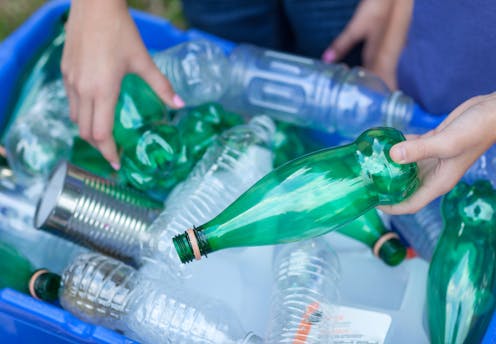Stemming the tide of trash: 5 essential reads on recycling
- Written by Jennifer Weeks, Environment + Energy Editor, The Conversation

A year after China upended global materials markets by banning imports of much solid waste[1], the effects are still rippling around the globe. Many U.S. recyclers are awash in materials they formerly sent to China for processing. Some cities with few options are burning recyclables in incinerators.
What would it take to reduce U.S. waste management headaches? These five essential reads offer some insights.
1. Embrace the circular economy
Waste is inevitable when products are designed to be used and then thrown away. Clyde Eiríkur Hull, professor of management at Rochester Institute of Technology, offers an alternative: a circular economy in which products are used, then recycled and remanufactured into new products[2].
Major U.S. companies, including GM, Caterpillar and Staples, are saving money through recycling and remanufacturing. But Hull says this could be greatly scaled up if the federal government required products to be designed with future reuse in mind and taxed goods that did not comply.
“In an entirely circular economy, the U.S. would most likely still import stuff from abroad, such as steel from China. But that steel would wind up being reused in American factories, employing tax-paying American workers to manufacture new goods,” he writes.
China’s waste ban has created a glut in the U.S. and sent prices for scrap materials plunging.2. Get serious about recycling plastic
Of all materials in the waste stream, plastics pose the biggest challenge. They are used in a myriad of consumer goods, including many single-use items such as straws and cutlery, and can take centuries to break down. Kate O'Neill, professor of global environmental policy at the University of California, Berkeley, compares plastic waste to J.R.R. Tolkien’s One Ring, which “can be permanently destroyed only through incineration at extremely high temperatures.”
O'Neill identifies a number of steps to boost plastic recycling[3] in the United States. They include better consumer education about sorting and disposal; less reliance on single-stream collection, which mixes plastics with other materials; more investment in scrap processing facilities; and steps to manage specific plastic products that are hard to recycle, such as 3D printer waste.
3. Pursue plant-based plastics – and composting
Conventional plastics are derived from fossil fuel, but they can also be made from renewable biological compounds[4] that break down more easily, such as plant sugars. A key challenge with these products is making items that are strong enough to hold up during use but still biodegradable.
“A straw and cup that disintegrate halfway through your road trip are not much use at all,” observes Michigan State University biochemist Danny Ducat, whose lab is using photosynthetic bacteria to synthesize bioplastic feedstocks.
Bioplastics also require investments at the end of their life cycles, Ducat notes. Like other plant-based materials, such as food scraps, they will only degrade readily in composting facilities, where microbes break them down in the presence of oxygen. Buried in landfills, they will persist for decades or centuries, much like conventional plastics. They also are likely to persist if they end up in other cold places with little oxygen, such as the Arctic or deep ocean waters.
“This means that any breakthroughs in materials science need to be coupled with sustainable methods for bioplastic production and a well-oiled system to direct bioplastic goods into composting facilities,” Ducat writes.
Paper-based packaging is an alternative to plastic, especially for food products.4. Recycle more steel and aluminum
Recycling is much more developed for metals[5] than it is for plastics. In the United States, about 65 percent of old steel products and 40 to 65 percent of discarded aluminum products are recycled. But Daniel Cooper, assistant professor of mechanical engineering at the University of Michigan, asserts that more could be done.
As Cooper explains, the United States exports or throws away a lot of cheap scrap metal, and imports expensive new metal. “As an already industrialized country, the U.S. needs little new metal to meet domestic demand,” he points out. More federal support for metals recycling, he asserts, could slash new steel and aluminum imports.
In addition to saving the money and resources that go into producing new metals, such a policy would cost Americans much less than the tariffs President Donald Trump has imposed on imported steel and aluminum.
5. Reconsider waste incineration
Is burning trash instead of recycling it such a bad thing? Bucknell University economist Thomas Kinnaman thinks it’s worth a new look[6].
As Kinnaman acknowledges, waste incineration is much less popular in the United States than in other regions, including Japan and western Europe. Early U.S. waste combustion plants generated high levels of air pollutants, including hazardous substances such as dioxins, and often were sited in low-income and minority communities.
But new incinerators burn waste more thoroughly and trap pollutants more effectively. “As a result, dioxin emissions from incinerators with modern abatement technologies are currently near zero. Modern incinerators also include processes to generate electricity, heat water for district heating services, recycle the metals found in the ashes and build tiles from the remaining slag,” Kinnaman states.
Incineration still has clear disadvantages. It’s more expensive than landfilling, and Kinnaman sees some evidence that once countries burn more than 40 percent of their waste, it starts to replace recycling. Nonetheless, he contends, expanding its use in the United States – which currently burns less than 13 percent of its solid waste – could be more socially responsible than shipping plastic scrap to developing countries that are ill-equipped to dispose of it.
Editor’s note: This is a roundup of previously published stories.
References
- ^ banning imports of much solid waste (theconversation.com)
- ^ recycled and remanufactured into new products (theconversation.com)
- ^ steps to boost plastic recycling (theconversation.com)
- ^ made from renewable biological compounds (theconversation.com)
- ^ much more developed for metals (theconversation.com)
- ^ worth a new look (theconversation.com)
Authors: Jennifer Weeks, Environment + Energy Editor, The Conversation
Read more http://theconversation.com/stemming-the-tide-of-trash-5-essential-reads-on-recycling-113306


